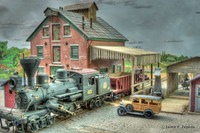October 2, 2011
The first step (1a) in instruction sheet labeled "A" is to clean and prime the metal castings. I was perplexed by this. I mean, the metal castings are all the cool details that get added on at the very end right?
You see, it helps to read all the instructions before doing any of the work. Granted, I've not read all the way through the 4 jumbo sheets of instructions. Why are these sheets so large anyway? And they are a really odd size. And I've noticed that they are not all the same size in some kits. What is up with that?!
Anyway, George first instructs the modeler to clean the castings and prime them. How to do this is found in a separate large sheet labeled "Detailing and Weathering Tips". George suggests using Floquil's "Earth" from a spray can. Luckily I had some handy. So that is what I will use. George explains how to clean any burrs and lumps on the metal castings with an Exacto knife or a single edge razor. I have plenty of those on hand as well.
Here is where I was faced with another decision. George instructs the modeler to prime the metal castings once they have been cleaned of burrs and lumps and parting lines. But, should I wash the metal casting prior to priming them? I mean, I'm going to be handling each and every metal casting to inspect them for burrs and lumps and parting lines (which so far I have found very few). I'm leaving oil and grime and taco sauce all over each casting. Should I wear gloves to do this? Why shouldn't I wash the castings?
Again, I chose to follow the instructions as written.
I suspect George instructs the modeler to get the castings done first so they can be ready as soon as they are needed. You see, it takes a couple of days for the primed castings to cure (so say the instructions). I surmise that George works so fast that by the time he is ready for the metal castings he does not have time to wait for them to cure. I surmise that George writes the kit's instructions as he is putting together the pilot model. But, I am not George Sellios! Heck, I've already established I'm only merely average. Should I wait and fiddle with the castings later? Should I dive right in to the plaster castings (step 1c in the oversized instructions sheet labeled "A")? After all, Yehuda's magic is the plaster! Right?!
Hold your horses Jaime. Follow the instructions.
And so, I begin to de-burr a minimum number of metal castings so I can prime them in Floqui's Earth from a spray can.
Behold the metal castings and the surgically precise average tools used to clean them:
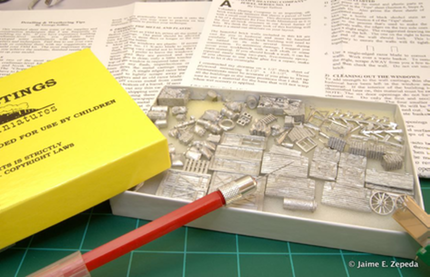
A while back my lovely wife bought me a lamp with a magnifier. She found it at a yard sale. I will put it to use here. This tip is not included in George's tome of detailing and weathering tips nor in his monumental instruction sheet "A". But I got to tell you, looking at all those tiny metal castings with naked eyes will get tiring. Thus, I'm adding my own twist to the instruction following. I'm using my magnifier lamp. I know, I should wash those little suckers after manhandling them but I won't to keep this experiment pure.
Behold the magnifier lamp aiding my average eyes to find burrs, lumps, and parting lines on all those exquisite metal castings:
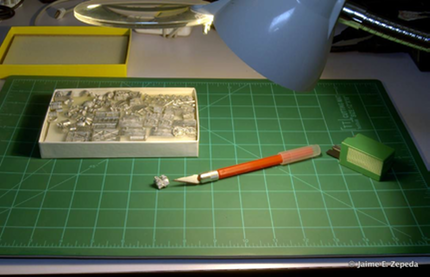
As I trudged through the task of cleaning the castings I decided to determine if the barrels, drums and what-nots were leveled on their bottoms. If they were not, I used one of Lisa's old emory boards to file the bottoms as flat as possible. I am only average so I knew perfection is not yet attainable. I only want the metal castings to stand up straight an not "tump" over. Tump is a bone-fide Southern term. Look it up.
Behold the discarded emory board used to straighten up wayward FSM delicious metal castings:
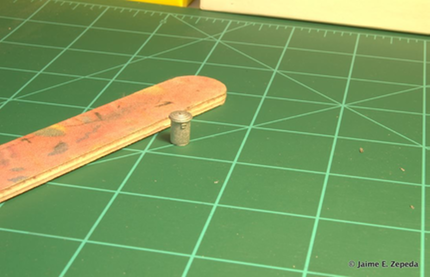
As I inspected each and every FSM metal casting I sorted them into "done" and "undone". Now that I look at the photo I should have labeled each bin. Aha! Already FSM kit building is making me a better modeler. That $265.00 plus $15.00 shipping is providing a valuable return on investment:
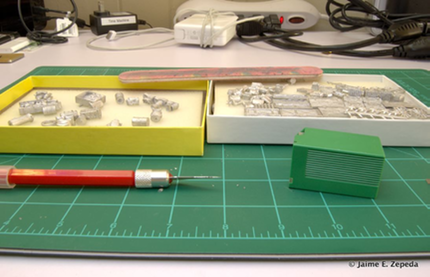
And thus, I have a batch of FSM lovely metal castings ready for priming with Floquil's Earth from a spray can:
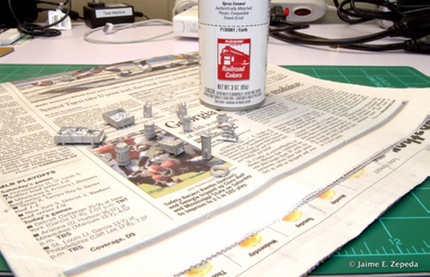
Next up, the priming.
